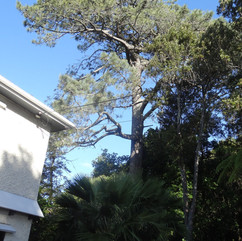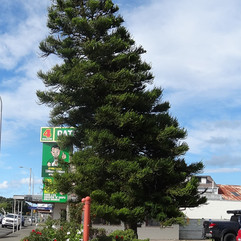Newsletter -April 2025
- pukekurafriends
- Apr 30
- 9 min read
Updated: May 2


Events Programme May 2025
6th - Wanderers’ Walk - Lead - Alan Metcalfe.
Local Park historian, member of the Friends and volunteer buggy driver, will lead us on an informative historical walk through the Park.
15th - Committee meeting
20th - Wanderers’ Walk - Lead Cliff Lawrence.
Cliff Lawrence will lead us around trees of Gondwanaland. Cliff is a past president of the Royal NZ Institute of Horticulture. His profile states : "Born and bred in Taranaki, with farming experience. Cliff is also an avid gardener and a dendrologist”.
His garden looks impressive. I think his talk will be very interesting.
22nd - Thursday evening meeting
Thursday’s speakers will be from the NPDC Events team, to talk about the planning and logistics of events and future needs, in Brooklands Park particularly.
Review of April's Events
March 27th AGM
Around 22 of us attended the AGM in March. We had one resignation from a long serving member and Buggy Coordinator John Konijn. Huge thanks for your contributions John.
Our new member is Lois Harrop – one of our buggy drivers. The committee have a busy year ahead and are well into many of the tasks discussed, namely tree signage replacements, Nature Walk books updating to name a couple.
After the meeting, Hamish and Sharon Guthrie from Taranaki Media Archives played a movie. The history was fascinating and at times hilarious…. good to see. We were especially proud to learn Alan Metcalfe was instrumental in collating much of the footage. Big thanks to all.
Also at the AGM, Alan presented the Friends with a copy of his newly published book “The History of Pukekura Park”. This has also been distributed to schools, libraries throughout the region but not for public publication as yet.
However, if there is enough interest, copies can be made available at a cost of approx. $25 per book.
Please indicate your interest by return mail.
Alternatively, a copy is available on the website - https://www.pukekura-history.co.nz/

April 1st - Wanderers' Walk
Tony Burrell led a group of 10 eager wanderers looking at some notable trees in the park or at least their representatives. The walk started behind the Bellringer Pavilion where stands a puriri which is thought by some to be one of the four ceremonial trees planted on the opening day of the Park. Other tree visited in this area were the notable Kermadec nikau (Rhopalostylis baueri) and learnt the differences between the New Zealand nikau and the Kermadec Nikau, the large Norfolk Island pine which at Christmas time often has a cross placed on it during the FOL, the giant Sequoia (Sequoiadendron giganteum) near the curator’s former office probably planted in 1877-8 by James Davis. On the eastern side of Sunken Dell we saw a Dawn Redwood (Metasequoia glyptostroboides), this species which was thought to be extinct was discovered in China in the 1940s.
Next was a coastal redwood (Sequoia sempervirens) on the northern slope of cannon Hill. It is a fast-growing giant softwood, native to California and extensively planted in New Zealand. We then stopped at the Gingko biloba by the Waterwheel on route to the Torrey pine in the Children's Playground. Until 2004 this tree had a substantially taller mate which was thought to be the tallest of its kind in the world. It was hit by lightning and subsequently removed.
The final tree on the walk was a visit to the Morten Bay fig which is thought to have been planted in 1895. This tree always gets the attention of visitors.
Tony also talked about the Cook's pine, which has the unusual habit of growing towards the equator. An example of this tree can be seen outside the Four square in Pātea.
Many thanks to Tony for a very interesting and informative walk. For more information about the background of some of the trees visited please read the attached write-up provided by Tony.
April 15th - Wanderers' Walk
Daniel Coombes from Taranaki Regional Council led an enthusiastic and informative walk through Pukekura today. His focus was on 11 pest plants to be found in the park. The plants he had listed were: mile-a-minute, moth plant, cathedral bells, old man’s beard, kahili ginger, climbing asparagus, bomarea, Elaeagnus, Japanese honeysuckle, jasmine, and tuber ladder fern. Nine of these plants are vines and have the ability to overwhelm other trees and shrubs. It has been estimated that at least 80% of our exotic vines in NZ, have a weedy propensity and can cause extensive problems in the wild.
It’s always helpful to be able to see where these invaders are growing in situ, especially to understand just how they spread. It was fascinating to see cathedral bells (cobaeaceae scandens) growing near the cricket nets. This is a plant that is rarely seen in Taranaki and is often only discovered when the pink flowers are spotted on the ground. The one, we saw today was more than 20ft high in the treetops. It develops large green seed capsules, which release winged seeds. Quite possibly this weed had arrived courtesy of a neighbour in the area. National Pest Plant Accord Species.
Mile-a-minute (Dipogon lignosus) so named because purportedly it can grow 15 cm a day. It spreads its seeds from pods by ‘explosive dehiscence’ meaning that when the seed pods burst, the seeds can be flung quite a distance. National Pest Plant Accord Species.
It is important to conduct follow up checks after removing invasive plants. Seed may be viable in the soil for many years (gorse possibly 40 years), but root and stem fragments may also regrow. Sometimes spraying does not completely kill plants and weeds such as climbing asparagus can survive somehow via their rhizomes and tubers and resprout 2 to 3 years later.
Thanks Daniel-we really enjoyed and appreciated listening to you today and learnt so much.
Taranaki Regional Council
Regional Pest Management Plan for Taranaki.
Taranaki Regional Council Biosecrurity Strategy 2018 - 2038
National Pest Plant Accord – NZ Government publication 2020.
NZ Plant Conservation Network website –-search for an exotic plant from a list of over 2,500 naturalised plants. https://www.nzpcn.org.nz/
Landcare Research website - Weed Identification Key helps to identify over 650 weeds.
Weedbusters -
https://www.weedbusters.org.nz/. Taranaki Weedbusters booklet also available
Northland Regional Council – Pest Control Hub.
Excellent site for identifying pest plants-clear photos and descriptions
Facebook hosts many sites of interest especially volunteer groups working all over the country. One general site which hosts a zoom meeting every 2 months with a relevant speaker is:
EWC - Environmental Weed Collective https://www.environmentalweedcoalition.com/
DOC published a list of 306 environmental weeds 2024
iNaturalist - https://www.inaturalist.org/ This is a global online site for identifying and recording all organisms, but weeds feature. Fascinating to learn about the natural homes of our weeds and just how widespread around the world many of these plants are. It is a free site.
Dot McKay
April 24th Evening Meeting
The audience of 22 were well engaged by the Thursday speaker Tony Burrell (with help from Anne!) regarding their recent trip - Aotea Great Barrier Island ‘Spectacular by Nature’ Garden Tour.
The trip was sponsored by Kiwi Gardener, after Tony and Anne entered a competition and won.
Tony gave a detailed background about the flora of the island and the geographic feature. He mentioned the roads which are narrow but in very good condition (no heavy trucks) and the self-reliance of the residents. Each property must be self reliant in terms of power(usually solar with generator backup), waste disposal, water etc.
Tony regaled stories of the various gardens they visited – so different to what we see in our Taranaki backyard. The main gardens visited were Puketaha, Rishworth Retreat (community garden), Taumata (400 acre farm running down to the beach at Mulberry Bay)and the Hidden Garden. A boat then took them to Julie’s Whare with ancient Pohutukawa and the Potato Patch.
Standout plants, only found at the top of Windy Canyon were:
The Great Barrier tree daisy (Olearia allomii), which is native to Aotea and nearby Hauraki Gulf islands.
Prostrate (ground-hugging) form of kānuka, Kunzea sinclairii only found in inland areas of Aotea.
Hills covered in flowering kanuka.
Tony also covered the talk they had on Aotea by Jules Moore landscape designer (Taranaki born) who had recently been awarded a gold medal for her entry in the prestigious Singapore Garden festival. The popular biennial festival brings together award winning designers, florists, and horticulturists from 18 countries to compete in various competitions, showcasing the skills of leading floral and garden designers globally. Jules was the first New Zealander invited to enter. Her tropical garden entry and the back story behind it was fascinating. Pictures of her entry are shown below.
Alan Metcalfe then introduced us to his new website - https://www.pukekuraparkhistory.com
The website has been set up as a living document, and Alan is constantly updating and revising. It contains a wealth of information and is highly recommended as a site to peruse. His recently published book – The History of Pukekura Park is also included – a read difficult to put down! Many thanks Alan for creating such a valuable asset.
Sue Matehaere Patten
Wedding Buggy
Gold Stage Coach, Waka, Horse, Taxi and now in 2025
the Friends of Pukekura Park Buggy
Over time, bridal parties have chosen a variety of different methods of transport for their wedding ceremonies and photographs. During the last month three bridal parties have chosen the FOPP buggy.
In keeping with the occasion the dashboard of the buggy was decorated with hydrangeas for the most recent wedding. The buggy met the bridal party and guests at Rogan Street and transported them to the Fred Parker lawn. This enabled the grandmother of the bride to be part of the photographs in the park and what a stunning backdrop for such an occasion. Many of their photos were taken in the Fernery.
Dressed in their very beautiful dresses the flower girls were excited to show us their dresses and shoes, and the all important accessories. They certainly enjoyed the buggy ride as much, if not more, than the adults.
With increased promotion, including photographs of bridal parties using the buggy, this could provide an increased income stream for the FOPP.

From the Zoo
Article by Kelly Green – Brooklands Zookeeper.
It’s that time of the year! Taranaki is bursting at the seams with events and visitors – and up here at the zoo, this means periods where we are closed to the public, mostly due heavy vehicle movement around the zoo and on Brooklands Park Drive.
But the work for us keepers doesn’t slow down; we continue to maintain high standards of care, often using the opportunity to get big jobs done that might involve moving animals or closing habitats.
For our free-flight aviary, this translates to annual catch-up time! We’ve worked hard on recall training our aviary birds to go into a smaller cage on cue so we can catch them in a smaller space. The catch-up is about getting a good hands-on look at each bird, otherwise this mainly only happens when they need to be caught for a medical issue.
This works well, with only a few individuals needing to be netted by experienced staff.
While our birds are individually visually checked from a distance and counted twice every day, once a year we catch-up and health-check every individual.
We weigh, body score (assess body condition by feeling their keel/breastbone) and worm them. We can also check microchips are working and that identifying leg bands are all fitting well.
Important things to look at are feet, eyes, beaks, nares (a fancy name for nostrils) and inside their mouths. This isn’t something the birds enjoy so knowing how to handle them safely is very important.
Some are very vocal (king parrots, I’m looking at you!) so we often need to use ear protection too.
Once given a clean bill of health, they are released back into the aviary.
Farewell Fernando the Capybara
Article by Jolene Beattie (Senior Keeper)
On 6 March, Fernando the capybara left Brooklands Zoo, travelling to Wellington Zoo to be introduced to their female Dia.
Fernando was collected by two of the keepers who would be looking after him once he arrived at his new home. Fernando had been the only capybara at Brooklands Zoo since his brother passed in 2023. Although he had been content since then, the opportunity for him to be paired with a female was fantastic for him.
In preparation for his journey, a large metal transfer crate designed for capybara (being the largest rodent in the world, wood is not a good option) was placed into his habitat a few months before his leaving date. Keepers started making the crate a positive space by feeding him some of his favourite foods – such as corn on the cob, carrot and apple – while he was in the crate every day.
Keepers stood slightly closer to the crate each day, and he got very good at being in it with keepers standing next to it. The idea was that on the day of his trip, we would be able to shut the door behind him.
As the 6th March was right in between two large events, Te Matatini and WOMAD, and there were many new noises, Fernando decided on the day that he didn’t want to go near his crate while it was in his habitat. Instead, we moved it to the farm path, which worked a treat – he walked down the path and into his crate without a problem.
He instantly sat down in his straw bed, with a travelling snack of corn on the cob and lettuce, and with the help of the Wellington Zoo keepers, we lifted him into the van that was going to transport him south.
It can be very hard for the keepers when an animal is moved to another zoo. You do build bonds with the animals especially when you are caring for them every day, but I am sure he will enjoy his time down at Wellington Zoo and hopefully in the future he will have some offspring.
Friends of Pukekura Park Membership Application Form
To apply for membership, either click on the link to our website page or download a pdf application form
Copyright © 2024 Friends of Pukekura Park, All rights reserved.


















































Comments